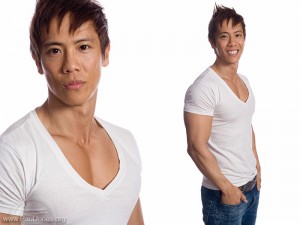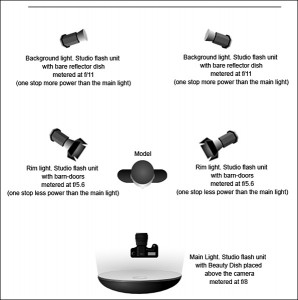“White on white
light, sublime, subliminal
The void is clean
a cell but not for a criminal
Light and shade
Time and space
M. I. N. I. M. A. L.
Minimal Minimal”
Pet Shop Boys ‘Minimal’
A photographer friend confided in me that her biggest problem, and fear, in the photography studio was trying to get a clean, pure white background in her photographs.
And the thought of the model / subject wearing a white shirt or white outfit against a white background totally freaked her out.
I asked her, “if the model was wearing a blue or red shirt would that make your job easier?” When I got a “Yes” from her, I went on to explain that it’s just about getting the right exposure on the subject and background, regardless of whatever clothes the subject is wearing.
I personally quite like the ‘white on white’ look, as you’ll see in the photos of Simon below.
A pure white background
This question of how to get a pure white background is always cropping up on photography forums and with the studio photographers I speak with. Whether you refer to it as ‘high key’, ‘pure white’ or ‘hot white’, it’s certainly a hot topic of debate.
One photographer I’ve spoken with told me that his method is to totally blow out the background by blasting it with light that is four stops more powerful than the main light. Another photographer maintains that you shouldn’t have to have the background light any more than one-third of a stop more powerful than the main light.
At least they’re both agreed on one fundamental point. The key is to have more powerful lighting on the background than on the model. When it comes to arguing about how much light is enough, I’d say carry out your own tests and use whatever works best for you.
I go one stop more powerful
When I first started out in studio photography, a studio owner friend showed me the method that he used and it’s more or less stuck with me through the years. Have two lights on the background, slightly feathered so that you’re getting a good, even spread of light across the whole background. The studio lights will usually be fitted with either largish reflector dishes or umbrellas. The output is metered to be one stop more powerful than the output from the main light.
So, what does ‘one stop more powerful’ actually mean…?
- If your main light on the model is set to f/5.6, then the background lights would be set to f/8
- If your main light on the model is set to f/8, then the background lights would be set to f/11
Tip! If you’re not sure how to work out exposure and don’t know what an ‘f stop’ is, take time to learn! Studio photography is made so much easier when you’re not relying on guesswork.
This ‘one stop more powerful’ method tends to work for me, but by all means feel free to improvise and use your own settings. There are no rigid rules in photography.
The lighting diagram below shows the setup that I used to photograph Simon in a white shirt against a white background. Don’t feel that you have to include the additional rim lighting. I just liked the extra dash of light in the hair and across the cheekbones.
Click on the images to enlarge them and feel free to post any comments.
Thanks for reading.






